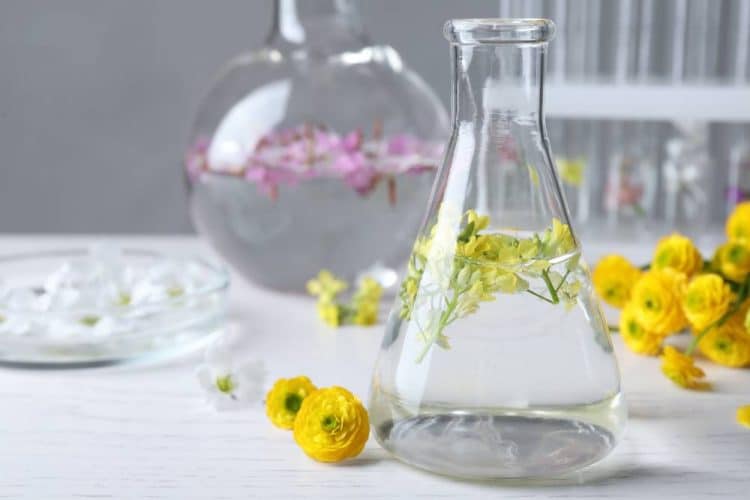Botanical extractions brought flavor, scent, and therapeutic properties to many products before the modern isolation and production of chemical additives. For centuries, the cosmetic industry relied on perfumes and oil or alcohol-based extractions of various flowers, spices, and woods.
Today, many cosmetic products use lab-created chemical derivatives of the active ingredient from botanical extractions. However, many companies are moving towards more natural products that use straight botanical extractions. As the industry moves further into the more natural realm, the liquid botanical extraction market could be worth over $5 Billion by 2029.[1]
What Are Botanical Extractions?
These are plants soaked in water, alcohol,oil or other solvents. The active ingredients are extracted from the plant matrix and move to the solvent solution.
Essential oils, perfumes, and teas are examples of botanical extractions.
Through the extraction process it is possible to isolate the scent, flavoring or active pharmaceutical ingredients (APIs) contained in the plant. These can be used in multiple preparations, including tea, creams, capsules, foods, cosmetics, medicines and numerous other products.
Why Is The Industry Promoting Their Use?
Many people are tired of chemicals and want to go back to natural additives. They flock to products that promote various botanical extractions, including aloe, vitamin E, and Shea Butter. [2]
Just because a product uses botanical extraction does not mean that it is any safer or more effective than other kind of synthetically made products. Many companies still use the same chemical-based formula and add trace amounts of botanical extract. Be sure to read your ingredient list before purchasing!
What Are The Common Extractions?
Every flower, tree, root, herb, and spice can be extracted through a solvent.[3] The most common ones you’ll see are:
- Aloe
- Vitamin E
- Green tea
- Calendula
- Chamomile
- Fruits of goji, raspberry, acai, and blueberry
- Beets
- Eucalyptus
- Soy
- Pine bark
- Shea and cocoa butter
- Coffee
- Lavender
Depending on the extracted molecules there will be different benefits for the health and the overall wellbeing. Aloe and Vitamin E, for instance, help soften the skin. Calendula helps reducing skin irritation, particularly in infants. Green tea and various fruits are high in antioxidants. And so on.
Although they have health promoting properties and smell fantastic, many commercially marketed products do not contain enough active ingredients to produce a therapeutic effect. If you’re looking to treat a health issue with a botanical extraction, visit a licensed Natural Health Practitioner such as a naturopath or Traditional Chinese Medicine practitioner.
Are Botanical Extractions Really Safer and Better?
In general, botanical extractions can be safer than synthetically produced products. They often contain buffers and counter components that moderates the effect of the active ingredient. It usually takes more of the botanical extractions to cause an effect compared to lab-designed molecules.
However, botanical extractions are unregulated and can vary widely in their production and active ingredient content. Trace elements of undesirable components can be found in some products, such as cannabidiol (CBD) oil. Although illegal, most CBD products have traces of the major psychotropic compound of cannabis, tetrahydrocannabinol (THC).
Botanical extractions offer an alternative that can guarantee results for many people sensitive to various chemicals added to lotions, makeup, and shampoos.
References:
[1] Meticulous Market Research Pvt. Ltd. Liquid Botanical Extracts Market Worth $5.25 billion by 2029. Global News Wire. (2022) https://www.globenewswire.com/news-release/2022/02/15/2385472/0/en/Liquid-Botanical-Extracts-Market-Worth-5-25-billion-by-2029-Exclusive-Report-by-Meticulous-Research.html
[2] Greta Faccio et al. Plant Complexity and Cosmetic Innovation. iScience. 2020 Aug 20;23(8):101358. https://doi.org/10.1016/j.isci.2020.101358. [Journal Impact factor = 5.458 ] [Times cited = 15]
[3] Stallings AF, Lupo MP. Practical uses of botanicals in skin care. J Clin Aesthet Dermatol. 2009;2(1):36-40 [Journal Impact factor = 1.57] [Times cited = 83]
Image: https://www.bigstockphoto.com/image-422913155/stock-photo-laboratory-glassware-with-flowers%2C-focus-on-flask-extracting-essential-oil-for-perfumery-and-cosmet











